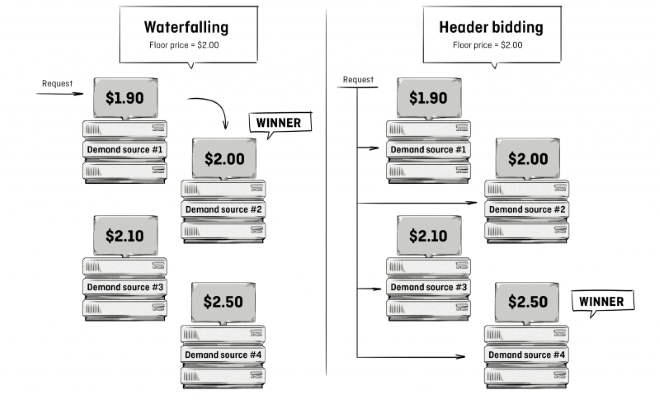The Benefits Of Header Bidding For Publishers And Advertisers
Reading Time: 6 minutesWith more and more platforms manifesting header bidding solutions, programmatic buyers- advertisers and publishers are promptly familiarizing themselves with how this technology truly works. However, despite the many benefits of header bidding, it is undoubtedly a subject that causes confusion. This is most likely due to the extensive list of jargon and acronyms attached to the process.
So in this article, we will be understanding what header bidding is and the benefits it brings to both the publisher as well as the advertisers.
What is Header Bidding?
Header bidding is a programmatic technique that enables publishers to offer their inventory to multiple ad exchanges at the same time, before making ad calls to their servers. It is a real-time bidding process that makes sure that every impression is sold to the highest bidder. Header bidding is the successor to the waterfall setup. It is called header bidding because the code that promotes the auction is in the header section of the HTML source code of the publisher’s website.

In the case of the waterfall setup, ad impressions were auctioned in a bulk form. Publishers tried to maximize revenue by passing on unwanted, available ad inventory to other buyers in a queue. So the unsold inventory would move from one ad network to the next in a subsequent manner, hence the name waterfall. This resulted in the ad inventory often being undersold in the first few auctions. And it would happen even when higher bids were waiting down the line.
Header bidding, on the other hand, is created to level the waterfall hierarchy. The ad call is sent out concurrently to all bidders in an auction and the highest bidder wins. This means that the publishers can obtain more demand and increase their fill rates, while buyers can obtain more inventory and unlock better chances to reach their target audience.
How Does Header Bidding Work?
Header bidding depends on a piece of JavaScript in the publisher’s header tag that allows buyers to bid while the rest of the page content loads. When any user opens a web page, the header tag connects them to multiple ad networks.
These ad networks then place their bids, and the winning bid is delivered to the user, who passes the bid to the publisher’s ad server. The publisher’s ad server then redirects the user to the advertiser’s server, which delivers the final creative. All of this happens within a few fractions of a second, hence, hardly noticeable to the human eye.

How Does Header Bidding Benefits Publishers
More Demand Sources
When compared with waterfall, header bidding opens up a broader supply of buyers. Many of them might otherwise not show any interest in accumulating scraps on the tail end of the auction. Header bidding allows publishers to work with more advertisers, both in terms of numbers as well as variety.
Greater Fill Rate and Revenue
With a greater number of advertisers participating in the auction, the chance of getting a better fill rate increases automatically. Every impression is auctioned optimally by analyzing bids from all the demand partners. This in addition to the fact that more advertisers can participate in the bidding, results in an increase in the overall revenue for the publisher.
Transparency
Header bidding allows publishers to auction the ad inventory on a per-impression basis. As a result, the publisher can keep track of the ad transaction data for every impression. Moreover, the process makes it easier for publishers to confirm the sale or auction of an impression.
Better Management
Thanks to the header bidding wrapper, the organization as well as management of the auction gets easy. The header bidding wrapper is a Javascript tag that dwells on the publisher’s webpage. A wrapper is primarily useful for organizing multiple demand partners and setting the rules for running the auction.

How Does Header Bidding Benefits Advertisers
Access to Premium Inventory
Before the use of header bidding, publishers would sell their premium inventories in the private marketplace. This would result in lower quality inventory being available in the open market. However, header bidding brought a change to this pattern. Now, advertisers have a complete view of publishers’ inventories and can easily bid and secure their ad placements.
Better Ad Targeting and Reach
The use of header bidding has enabled advertisers to have a better view of the ad inventory. This also includes the number of impressions and demographics of the website visitors. With the help of this data, an advertiser can work on their target strategy more efficiently. It is also much easier for buyers to now reach their audience at scale.
The drawback of Header Bidding
Despite the many advantages and benefits of header bidding, there are a few downsides to it as well. For instance:
Technical Know-How
The header bidding code goes into the header section of a webpage’s HTML code. Hence from the creation of the code to the point of implementation, it requires technical knowledge as well as a fair number of engineering hours.
Increase Page Latency
The bidding starts even before the content loads, as soon as a visitor opens a web page. While the process only takes about a fraction of a second, it does build latency. This issue is usually fixed by using timeout settings or by using server-to-server header bidding.
Security Concerns
The act of selling inventory in the open market can result in attracting fraudsters. Hence, any data leak can be a major issue allowing fraudsters to hack a user’s personal account or devices.
Concluding Words
There is no dilemma about how header bidding is a major improvement over the waterfall setup. While it is complicated to set up and has the tendency to increase a page load time, header bidding is still being practiced and offers a greater yield.
Moreover, Google has replaced header bidding with its own version known as exchange bidding. For the publishers who use Google services, this can be a major change.
Irrespective of that, the key attractions remain the same, i.e. the publishers want to have control over their ad inventories, to increase their ad inventory revenue, as well as to determine a way to reduce page latency. So with those factors behind, it is safe to conclude that header bidding is here to stay.
FAQs:
1. What is header bidding?
Header bidding is a programmatic technique that enables publishers to offer their inventory to multiple ad exchanges at the same time, before making ad calls to their servers. It is a real-time bidding process that makes sure that every impression is sold to the highest bidder.
2. What is the waterfall system?
In the case of the waterfall setup, ad impressions were auctioned in a bulk form. Publishers tried to maximize revenue by passing on unwanted, available ad inventory to other buyers in a queue. So the unsold inventory would move from one ad network to the next in a subsequent manner, hence the name waterfall.
3. How does header bidding work?
When any user opens a web page, the header tag connects them to multiple ad networks. These ad networks then place their bids, and the winning bid is delivered to the user, who passes the bid to the publisher’s ad server. The publisher’s ad server then redirects the user to the advertiser’s server, which delivers the final creative.
4. What are the benefits of header bidding for publishers?
- When compared with waterfall, header bidding opens up a broader supply of buyers.
- With a greater number of advertisers participating in the auction, the chance of getting a better fill rate increases automatically.
- Header bidding allows publishers to auction the ad inventory on a per-impression basis.
- Thanks to the header bidding wrapper, the organization as well as management of the auction gets easy.
5. What are the benefits of header bidding for advertisers?
- Advertisers have a complete view of publishers’ inventories and can easily bid and secure their ad placements.
- An advertiser can work on their target strategy more efficiently. It is also much easier for buyers to now reach their audience at scale.
6. What is the downfall of header bidding?
- It requires technical knowledge as well as a fair number of engineering hours.
- It increases page latency.
- The act of selling inventory in the open market can result in attracting fraudsters.



